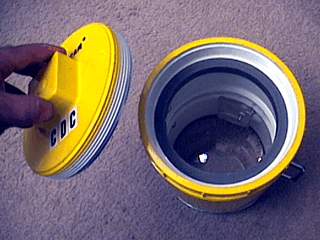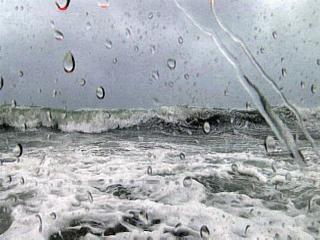Good day, Dave
The clear end of the unit is 1/4" plexiglass (acrylic) disk I cut into an 6" circle and glued it to the flange / indet in front of the pipe. A Dremel rotary tool worked wonders with this project.
Essentially, it is a coupling for a 6" PVC pipe, with two "convertors" on each end to allow a 6" screw-on end cap to be used. One of these ends forms the screw-on side, where the end can be opened via a 6" PVC screw cap, the other end has been cut and "dremmeled" so that the 6" window fits flush in that end and is sealed in place with silicone cement. If may leak slightly if submerged for some time (through the "threads" in one end) but remains totally dry in side-ways rains and hurricane chases. Got lots of great shots through this one using my older TRV-110 camcorder!

The newer unit, I built from a bar-top game my neigbor was throwing out, beleive it or not. It is simply a box contructed from 1/2" thick lexan / acrylic with a "mail box" style door that latces shut on the open end. The HDR-FX1 camera, with lense hood, fits perfectly on its internal mount, and two mikes hook up to a stereo 1/8 standard phono plug for the camera's external mike. Works fantastic, and stays dry even under a few feet of water, although I designed this specifically for splashes and hurricane (sideways) rains.
A sealing rubber "tape" strip gasket fits tight when the opening door is latched shut. The entire unit, is the original orange from the bar-top fooz-ball table I dismantled, except for the front window, which is clear. Three handles are cabinet "U" handles, one in the front, two on each upper-side. Two microphones were made from the simple computer PC mikes, two of them, and are on the front sides of the unit, sealed with thin plastic / rubber to protect the mike heads, while the sealed stems go inside and wires connect to the L and R inputs on the 1/8" stereo jack for the camcorder.
A clear viewport on top of the unit allows the external remove, in a zip-lock bag to easily be used, so the case need not be opened. The LCD of the camcorder also appears through this window as well. It works like a charm, and filmed lots of surge footage during Katrina as well.
Keep in mind, there is always a "home brew" and "professional" approach to anything, especially these kinds of stuff. If you are planning on filming underwater stuff, then go with the larger investment of a professional system, like Doug's. One single drop of water in a camera, that's it, especially if it is salt water. In my case, just for hurricane and storm chasing stuff, the homebrew enclosures, giving a little creativity, suited my purpose well.
Oh, and yes indeed - CDC logo, taxicab-yellow "warning" color, and condoms for protection - Scary ;-)








